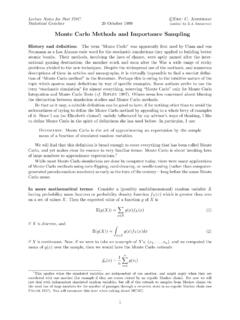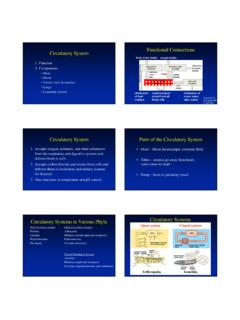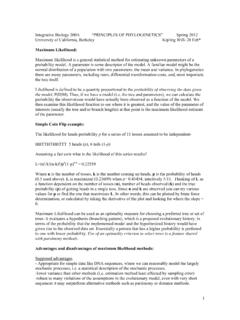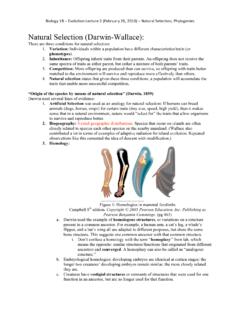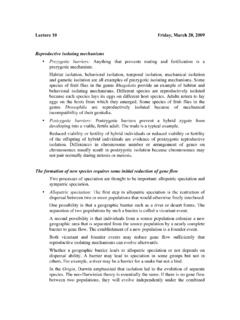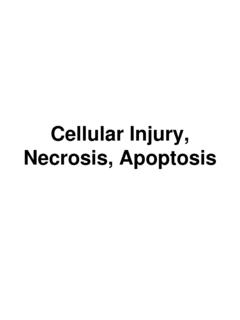Transcription of How do cells acquire energy? Why do cells need energy?
1 Todays OutlineMetabolismEnergy-Releasing PathwaysAerobic Respiration GlycolysisKrebs CycleElectron Transport PhosphorylationAnaerobic PathwaysEnergy and WorkATPM etabolic PathwaysEnzymesFeaturesFactors Affecting Enzyme ActivityMembrane TransportDiffusionOsmosisPassive TransportActive TransportBulk TransportThe cells capacity to:1. acquire Use energy to build, degrade, store and release substance in a controlled do cells acquire energy? By breaking down high energy molecules in or example: when we eat carbohydrates:1.
2 Digestion breaks these complex sugars down to glucose. 2. Glucose, a high energy molecule, is absorbed across the gut into your bloodstream. 3. An increase in blood glucose triggers the pancreas to release Insulin signals cells to start taking up more Glucose in the cell is the beginning of do cells need energy? cells need energy to do , rearranging,breaking apart substancesMechanicalmoving flagella, cell structures,parts of or the whole bodyElectrochemicalmoving charged substances acrossmembranesMetabolism1. To further understand how metabolism works we must introduce some concepts, processes and & Processes1.
3 Energy2. Gradients 3. Phosphorylation4. Membrane transport 5. Metabolic pathways6. Aerobic respiration7. Anaerobic pathwaysParticipants1. Glucose2. Adenosine triphosphate (ATP)3. Enzymes4. Cofactors5. MitochondriaEnergyEnergy is the capacity to do work and can t be created from does energy come from?Mostly from the sunEnergyTHERMODYNAMICS: 1st Law: Any isolated system has a finite amount of energy that cannot be added to or lost, but can be converted from one form to another.(conservation of energy) 2nd Law: Systems move from more ordered to less ordered.
4 (entropy)EnergyEnergy flows in one producersconsumersHEATE nergyEnergy is stored and released by building and degrading molecules (energy is stored in chemical bonds).1. Endergonic reactions Energy Exergonic reactions Energy INenergy-poor starting substances612 GlucoseEndergonicreactionsare required to produce energy-rich compounds like glucose (photosynthesis). Energy must be added to the reaction to convert low-energy molecules into high energy OUTenergy-poor products6+6 O2 GlucoseExergonicreactionsResult in the net release of energy (aerobic respiration).
5 Molecular bonds are broken in a step by step process so that cells can capture energy in a controlled Is the Cell s Energy Currency ATP(a nucleotide)ATP is used in numerous biological : provides energy for heat, nerve electricity, light (fireflies), muscle movement, pumping substances across membranes against a PathwaysMost metabolic reactions occur in orderly, enzyme-mediated sequences. These are metabolic pathways. Metabolic reactions start with reactants. Intermediatesare formed during the reaction. The substances at the end are known as metabolic pathways are reversible with products being converted back to reactants.
6 Reversible reaction help maintain an of Enzymes1. Nearly all enzymes are Speed rate of reaction by lowering activation Lower Activation Energyactivation energywithout enzymeactivation energywith enzymeenergyreleasedby thereactionproductsstarting substancedirection of reactionFigure from page 78 of your textFeatures of enzymes (Cont.)3. enzymes are not used up or permanently enzymes are substrate Affecting Enzyme Activity1. Temperature2. pH3. SalinityActual ranges of activities differ among enzymes . Figures &.
7 14 from page 81 of your Membranes1. Cell membranes are selectively CO2, O2, and small nonpolar molecules pass through the Polar water molecules slip though gaps in the cell membrane when the lipid bilayerflexes and Ions and large polar molecules such as glucose must pass through transport proteins in cell diffusion of water molecules in a concentration gradient across a selectively permeable moves in the direction necessary to equalize the and Active Transport1. In both processes, solutes move through transport proteins in the cell In passive transport, substances move passively (they diffuse).
8 3. In active transport, ATP is required to pump substances against a concentration gradient. Passive and Active Transport AnimationsPassive Transport:Solutes follow gradientsActive Transport:Solutes move againstgradientsBulk Transport1. cells use vesicles to expel or take in large items or large numbers of Exocytosis vesicle fuses with plasma membrane and contents are released outside Endocytosis cell surrounds items at outer surface and brings them inside, creating a and ExocytosisAnimationMetabolism1. All cells make ATP by pathways that release chemical energy from organic compounds such as cells store chemical energy as ATP to use in future reactions that require energy input.
9 MetabolismThere are two pathways for generating ATPfrom glucose:Aerobic Respiration requires O2 Anaerobic Respiration no O2neededAerobic RespirationThree steps:1. Glycolysis In Cytoplasm2. Krebs Cycle In Mitochondria3. Electron Transport Phosphorylation - MitochondriaGlycolysis MovieOverview of Aerobic RespirationCYTOPLASMMITOCHONDRIONGLYCOLY SISELECTRON TRANSPORT PHOSPHORYLATIONKREBS CYCLEATPATP energy input to start reactions2 CO24 CO2232water2 NADH8 NADH2 FADH22 NADH2 pyruvatee-+ H+e-+oxygen(2 ATP net)glucoseTYPICAL ENERGY YIELD: 36 ATPe-e-+ H+e-+ H+ATPH+e-+ H+Figure from page 111 of your textAerobic Respiration OverviewAnimationElectron Transport Animation Fig.
10 , p. 115 ATPATPATPATP36 ATP28422 ATPATP glucose2 PGAL2 pyruvate2 NAD+2 NADH2 FADH22 NADH2 FADH26 NADH2 acetyl-CoAKREBSCYCLEATPATPATPATP2 CO2cytoplasmADP + PiELECTRON TRANSPORT PHOSPHORYLATIONGLYCOLYSIS inner mitochondrial compartmentouter mitochondrial compartmentElectrons and hydrogen from cytoplasmicNADH are shuttled into inner compartment. Two coenzymes already inside transfer the electrons to a transport (8 NAD+, 2 FAD total) transfer electrons and hydrogen from remnants of pyruvate to a transfer flow through transport systemTransport system pumps H+to the outer compartmentAt ATP synthases H+ flowing back in drives ATP formation2 NADH for in the cytoplasmdIn third stage, NADHand FADH2 from second stage used to make 28 ATP by electron transport In third stage, NADH from glycolysis used to form 4 ATP by electron transport Krebs cycle of second stage, 2 ATP form by substrate-level glycolysis, 2 ATP used.
